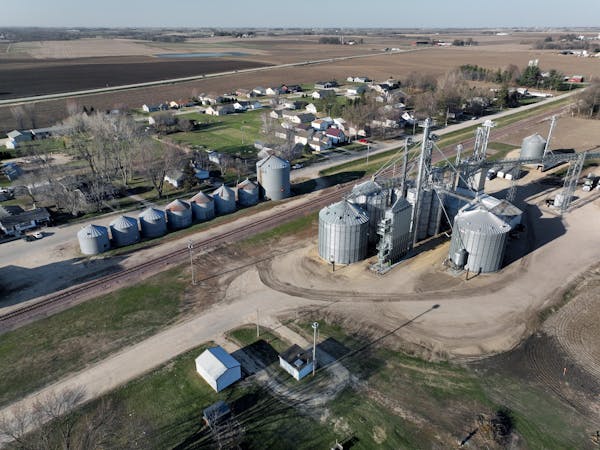The leader of the House environment committee wants Minnesota farmers to pay to clean up drinking water contaminated with a pollutant that mainly comes from agricultural fertilizers spread on row crops.
Rep. Rick Hansen, DFL-South St. Paul, said the state should increase its fertilizer fee to raise money to test private wells for nitrate contamination in southeastern Minnesota and provide bottled water for those who need a new drinking source.
"There has to be a 'polluter pays' model," Hansen said. "Once the general public picks up these costs there will be no incentive for change. Why would anything change if someone else will be cleaning up the mess?"
The EPA ordered the state on Nov. 3 to take several steps to address nitrate contamination in southeast Minnesota, including to provide safe water immediately to people who may be drinking from contaminated private wells.
Nitrate is a chemical that is dangerous in high quantities, and the porous geography of southeastern Minnesota makes wells particularly vulnerable to it. About 90% of the nitrate in southeastern Minnesota's water comes from nitrogen fertilizers spread on croplands, a state study found in 2013.
Despite spending hundreds of millions of dollars over decades on studies, stakeholder meetings, incentives and educational and voluntary programs, the state has made almost no progress in reducing nitrate pollution.
The most well-known effect of drinking water with high nitrate is the rare but potentially fatal condition called blue baby syndrome, in which infants are starved of oxygen. Federal regulators imposed a limit at 10 milligrams of nitrate per liter of water several decades ago to guard against that. Newer research links drinking water with even lower levels of nitrate to colorectal cancer, thyroid disease and neural tube defects.
In a response Friday to the EPA, the commissioners of the three state agencies responsible for preventing nitrate pollution defended the state's past work. A joint letter from Agriculture Commissioner Thom Petersen, Pollution Control Agency Commissioner Katrina Kessler and Health Commissioner Brooke Cunningham said they will provide vouchers for bottled water to "vulnerable residents," and will "again notify affected residents" of the hazard, the commissioners wrote. The state will come up with a plan by Jan. 15 to test wells, according to the letter.
The three commissioners said they plan to ask the EPA to pay for the work. They added that they will "conduct stakeholder engagement with an array of partners" to consider the EPA's suggestion to toughen up fertilizer and manure application permits.
Hansen said the commissioners' response is just more of the same.
"More stakeholder involvement, more monitoring and more testing," he said. "'Stakeholder engagement' has not worked for 34 years. We are just just delaying problem solving. We have to cut fertilizer use — that's it."
Hansen said the state needs to expand its conservation reserve program to buy up easements and take the land directly above well-heads out of agricultural production.
His proposal to raise fertilizer fees will face stiff political opposition.
Petersen and the Department of Agriculture asked lawmakers last year to raise the fee from 39 cents per ton to 64 cents to cover the cost of inspecting sources of nitrate pollution. The increase would have cost individual farmers an average of $20 a year, the agency estimated. The bill failed.
Lawmakers who represent southeastern Minnesota are pushing back against the EPA's findings and any new environmental rules for farmers.
U.S. Rep. Brad Finstad, R.-Minn., railed against the EPA for conducting a surprise inspection of three farming operations in southeastern Minnesota last month.
"The EPA is bending to the whim of environmental activists without any acknowledgement of the care that Minnesota farmers put into our soil management, our soil fertility, our nutrient management, or our precision ag practices," he said in a statement.
State Sen. Steve Drazkowski, R-Mazeppa, said he'd be against raising a fertilizer fee or having the cost fall to general taxpayers. He said that private well owners need to take some responsibility for ensuring their water is safe, adding that older wells that are out-of-code can be more vulnerable to pollutants than newer ones.
"When you build a house you need to make sure it's on stable soil, when you drive a car you make sure the brakes work and when you have a private well you should make sure it's up to code," he said.
Drazkowski said the EPA and environmental groups have overblown the danger of nitrate.
"They are treating this like it is some brand new man-made chemical," he said. "But it was here in the 1900s, it was here in the 1940s and here in the 1970s and practices and technology have only improved."
People have known about blue baby syndrome since the 1940s and they've been able to treat it and avoid it to the point that cases are extremely rare, he said.
A Minnesota Department of Health study found there were 10 cases of blue baby syndrome in the state between 2000 and 2016. It couldn't say how many of those were caused by contaminated well water.
Carolyn Parnell, 'trailblazer' who served as Minnesota's first IT commissioner, dies


